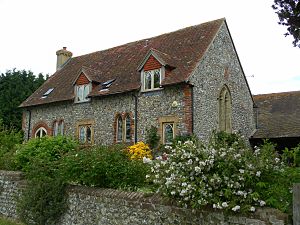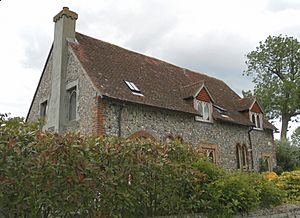Bilsham Chapel facts for kids
Quick facts for kids Bilsham Chapel |
|
|---|---|

The former chapel from the southeast
|
|
| 50°48′36″N 0°37′17″W / 50.8101°N 0.6215°W | |
| Location | Bilsham Lane, Bilsham, Yapton, West Sussex BN18 0JX |
| Country | England |
| Denomination | Pre-Reformation church |
| History | |
| Status | Chapel of ease |
| Founded | 13th century |
| Dedication | None recorded |
| Architecture | |
| Functional status | Residential conversion |
| Heritage designation | Grade II |
| Designated | 5 June 1958 |
| Style | Gothic |
| Closed | c. 1550 |
Bilsham Chapel is an old building in Bilsham, a small village in West Sussex, England. It was once a chapel, which is a small church building. It was built in the 1200s as a "chapel of ease." This means it was a smaller church for people who lived far from the main village church in Yapton.
Around the 1500s, during a time of big changes in religion called the Reformation, the chapel stopped being used for religious services. Since then, it has been used for different things. It was a storage building and even homes for workers. Since 1972, it has been a single house. The building is very important because of its history and design. It is officially protected as a Grade II listed building.
The Chapel's Story
Bilsham is a small area near the coast in West Sussex. It is about 1.2 kilometers (0.75 miles) southwest of Yapton village. People have found signs that Anglo-Saxon people lived here a long time ago. Bilsham was mentioned in the Domesday Book in 1086, which was a big survey of England.
The chapel building we see today was built in the 1200s. Some of its oldest parts are two windows on the north side. Experts think these windows were made around the 1260s. Other people believe they might be from the 1300s, like the pointed window on the east side.
The chapel was never named after a saint. In the 1500s, many small chapels like this one either became full churches or stopped being used. Bilsham Chapel closed around 1551. We don't know much about what happened to the building for the next 300 years.
In 1860, a study of churches said it had been turned into two small homes for workers. This might have happened around 1840. One wall was rebuilt with bricks at that time. More changes were made in 1878. Before 1965, the two homes became a shed. Then, in 1972, the building was changed again into one house, which was described as a "homely dwelling."
On June 5, 1958, Bilsham Chapel was given a special protection status. It was listed as a Grade II building by English Heritage. This means it is a "nationally important" building with "special interest." As of February 2001, it was one of many protected buildings in the Arun area.
How the Chapel Looks
The chapel is a small, rectangular building. It has always been one open space inside, with no walls dividing it. It has two floors. The walls are made of flint and sandstone. Red bricks are used for the corners, called quoins, and around the windows.
The oldest parts are two tall, narrow windows, called lancet windows, on the north wall. These windows have a special design called y-tracery, which was popular in the early 1300s. The pointed window on the east wall has two sections and might be from the 1300s or 1400s.
In 1878, two pairs of new lancet windows with red brick frames were added to the south wall. A wooden roof with tie-beams was also added then. The two simple windows on the west wall might have been put in at the same time. In 1972, when it became a house, two dormer windows were added to the roof on the south side.
In 1860, a survey noted that the original arched entrance on the north side was blocked up. It also mentioned "three solid stone buttresses" on that side. Buttresses are supports built against a wall. At that time, you could still see marks in the nearby field that showed where the old churchyard used to be. It was said to be quite large.
See also


